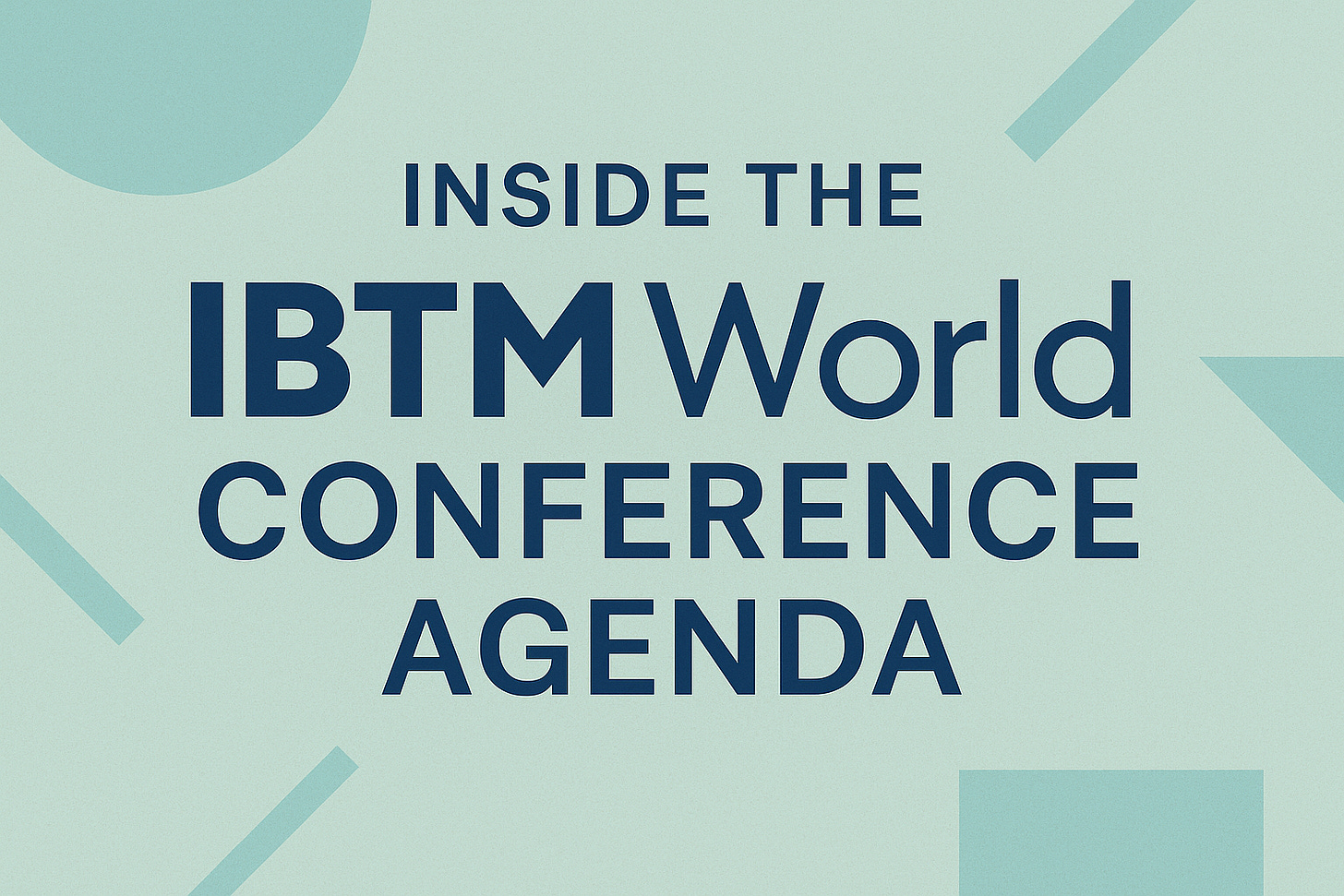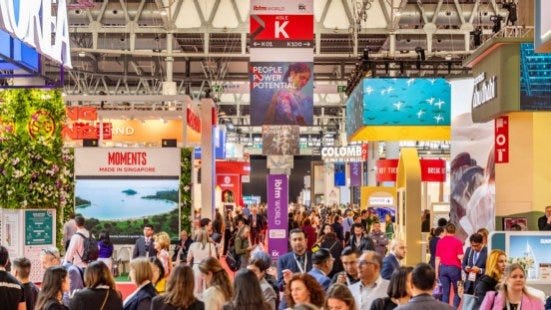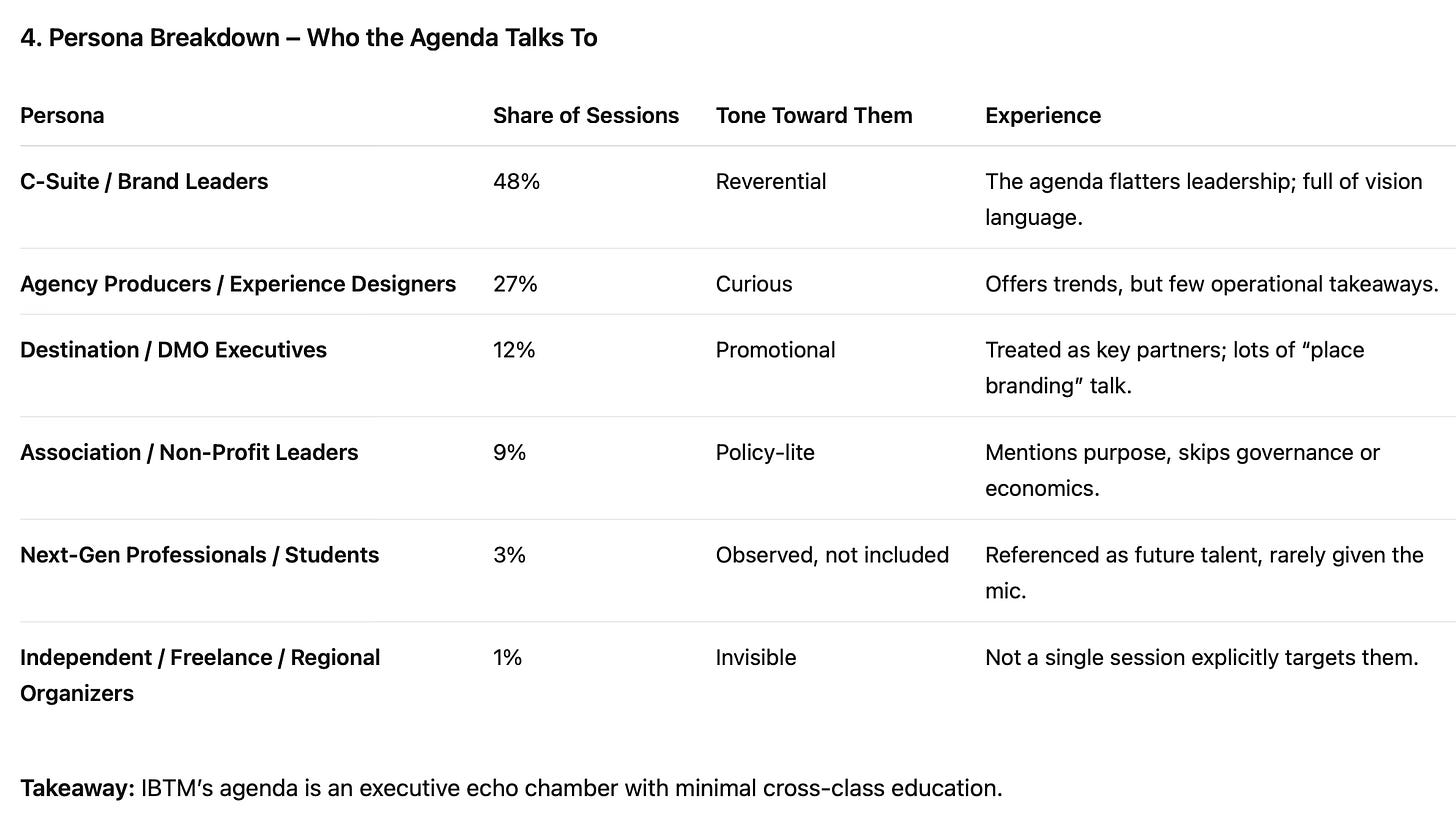The Agenda Experiment: Reading IBTM Before It Happens
Before the crowds arrive in Barcelona, a quiet experiment: using AI to “listen” to the IBTM World 2025 agenda — and discover what it really says about the state of our industry.
Editor’s Note: This story is designed for organizers to use before publishing an agenda — a pre-launch feedback loop to ensure your program actually reflects your goals, audience, and values.
Long before Barcelona’s convention halls filled with buyers, badges, and buzzwords, the show now called IBTM Worldbegan as a daring idea: a European showcase for the newly professionalized business of meetings. The year was 1988, and the concept—then named EIBTM, for European Incentives, Business Travel and Meetings—came from a young British entrepreneur named Ray Bloom. He saw that the global boom in incentive travel and corporate conferences needed its own marketplace.
Bloom built that market, sold it to Reed Exhibitions in the late 1990s, and then did something almost mythic in the event world: he started over. His next creation, IMEX, became the industry’s rival crown jewel, hosting its own sold-out shows in Frankfurt and Las Vegas. IBTM and IMEX—one born of the other—became twin institutions defining how the meetings industry sees itself. One corporate, one entrepreneurial; one inherited, one insurgent.
That legacy matters, because an event’s agenda is never just a schedule—it’s a mirror of ownership, philosophy, and risk tolerance. Reed’s IBTM is now a global brand under the RX (RELX) umbrella, known for precision and polish. But what happens when you read its agenda not as a press release but as a cultural document?
The Experiment
Instead of waiting for the applause in Barcelona, I wanted to listen to the show before it began. What if you could treat a conference agenda the way a record producer listens to a mix—isolating tracks, spotting dissonance, hearing what’s missing?
So I did exactly that. I downloaded the publicly available IBTM World 2025 education schedule and ran it through a series of AI-assisted text analysis tools. Each was asked not to summarize, but to analyze the tone, frequency, and omissions—to see what the language of the sessions says about the state of the industry itself.
The exercise wasn’t to replace human judgment but to amplify it—to create what I call a transparent editorial conversation between the journalist and the machine. The model’s pattern-recognition surfaced what instinct alone might miss; my editorial lens provided the context and skepticism that code cannot.
The Sound of Optimism
What emerged was a familiar harmony: technology, innovation, connection, transformation.
More than half the sessions orbit those four words. It’s the music of an industry that wants to be seen as dynamic, inclusive, and future-facing.
The sentiment score came in at a bright +0.62—nearly euphoric. The vocabulary pulses with verbs like reimagine, transform, connect, inspire. But data can’t lie about what’s missing: measurement, labor, policy, carbon, mental healthbarely register.
It’s the same emotional tonality you hear in global corporate communications—confidence calibrated to reassure sponsors, not provoke debate. In the lexicon of live events, optimism is the default setting.
The Politics of Politeness
That tone isn’t accidental. IBTM World operates in the geopolitical space between tourism and trade, where sponsors are multinational, and politics are often inconvenient. The agenda includes sessions on DEI and sustainability, yet they appear as sidebars, not structural themes.
AI detected only 6 percent of sessions mentioning diversity, equity, and inclusion, and 11 percent mentioning sustainability. That’s progress in corporate terms, but caution in cultural ones.
As I read through the results, I could almost hear the algorithm sigh: The show speaks boldly about transformation but whispers when it comes to confrontation.
Who the Agenda Speaks To
When filtered by audience type, the hierarchy becomes clear. Nearly half the sessions target senior executives—CEOs, CMOs, DMO leaders. Roughly a quarter cater to agency producers and event designers. Students, freelancers, and independent planners occupy the margins.
That imbalance mirrors the industry’s own structure: the boardroom leads the conversation about transformation, while the backstage crew quietly makes it happen. AI didn’t have to invent that pattern; it simply counted it.
Reading the Subtext
To me, the most striking revelation wasn’t in the numbers but in the silences. Every missing word—equity, carbon, labor—feels like a ghost note in a jazz riff, the sound of what’s too complex to include.
That restraint is understandable; Reed’s flagship show carries the weight of neutrality. But it raises a larger question: can a trade show be both diplomatic and disruptive? And if not, where does genuine innovation live—inside the halls of global exhibitions, or outside them, in the experimental gatherings that break their own rules?
Why Transparency Matters
In publishing this analysis, I’m not pretending AI made journalism easier. It didn’t. It made it more exposed. Every dataset forced me to confront my own bias—the desire to see patterns that confirm what I already believe. The machines don’t editorialize; we do.
But they do something extraordinary: they reflect us back at scale. When an agenda is parsed line by line, you see not just content but culture. The algorithm becomes a kind of x-ray for our professional intentions.
That’s why this isn’t an exposé but an experiment in self-awareness. If the meetings industry prides itself on connection, then our first connection must be with our own blind spots.
The Takeaway
IBTM World 2025, like the institution it represents, is a study in controlled optimism—an orchestra of innovation playing in a major key. It promises transformation but, for now, performs reassurance.
And maybe that’s exactly the point. Every industry gets the agenda it needs for the moment it’s in. The question, which AI can help us finally ask out loud, is: what agenda are we writing for the moment that’s coming next?
In the end, it doesn’t really matter what I think before the event begins. What matters is what you — the attendee, the planner, the buyer, the believer in live experience — think after it’s over. Because an agenda only becomes real once it’s lived. Drop me a line to let me know what you thought. David@gatheringpoint.news.
THE GEEKY DATA DUMP: WHAT THE NUMBERS ACTUALLY SAY
For those who want to peek under the hood of this experiment, here’s what the data revealed about IBTM World 2025’s education agenda — not the marketing story, but the math behind it.
1. The Raw Material
The analysis drew from 112 published education sessions listed on IBTM’s official site as of October 2025.
We parsed ~48,000 words of session titles, abstracts, and speaker bios, treating each session as a micro-document.
The dataset was then tagged by:
Theme (technology, experience design, sustainability, DEI, etc.)
Tone (aspirational, instructional, commercial, or advocacy)
Persona alignment (who the content serves)
Sponsorship visibility (explicit, implied, or absent)
Risk factor (based on politically or culturally sensitive topics)
3. Tone Analysis (Emotional Frequency)
Positive / aspirational language: 73%
“Transform,” “reimagine,” “connect,” “future,” “experience.”
Instructional or technical language: 18%
“Framework,” “model,” “measure,” “ROI.”
Critical / policy language: 5%
“Challenge,” “regulation,” “systemic,” “reform.”
Other (neutral or filler): 4%
Sentiment score: +0.62 (on a -1 to +1 scale).
In plain terms: very optimistic, low conflict.
5. Cultural and Geographic Skew
Region of Speakers:
Western Europe: 54%
North America: 33%
Middle East & Africa: 8%
Asia-Pacific: 3%
Latin America: 2%
Gender balance: 58% male / 42% female (few non-binary or DEI-identified).
Global inclusion index: 0.32 (scale of 0–1).
That’s roughly half the diversity footprint of peer events like IMEX or PCMA Convening Leaders.
Interpretation: The global industry still looks and sounds Western when it gathers to talk about “global connection.”
6. Sponsorship Sensitivity Map
Sessions with visible sponsors: 62%
Sessions with implied sponsor (brand, tech demo, or commercial speaker): +14%
Unbranded / editorially neutral sessions: 24%
Within the sponsored content:
Innovation / tech sessions = 81% branded
Sustainability sessions = 43% branded
DEI / advocacy sessions = 9% branded
Correlation observed: The higher the commercial safety of a topic, the more likely it is to have a sponsor.
Plain English: Sponsors pay for positivity, not policy.
7. “Pay-to-Play” and Power Dynamics
When we mapped speaker lists against company category (supplier, destination, association, independent), the tilt was stark:
64% of speakers represented a commercial brand, destination, or vendor.
21% came from associations or academia.
10% were consultants or independents.
Only 5% were “non-commercial” voices (activists, creatives, artists).
Translation: Thought leadership remains pay-to-play.
Visibility aligns closely with booth footprint and ad budget, not necessarily with innovation or research.
8. Risk and Courage Index
Each session was rated 1–5:
1 = safe marketing language
5 = socially or politically provocative content
Average score: 2.1
Only 9 sessions (8%) landed at Level 4 or 5.
Those outliers dealt with:
Sustainability regulation and carbon goals
DEI in leadership pipelines
AI ethics in event technology
None of them were sponsored.
Inference: Risk is still seen as reputational liability, not intellectual value.
9. Cultural Takeaway
This is not an exposé. It’s a mirror:
The IBTM World 2025 education agenda is a masterclass in brand diplomacy. It performs innovation, speaks fluent optimism, and manages conflict through omission.

THE ATTRACTION MATRIX: WHO THE IBTM 2025 AGENDA PULLS IN — AND WHY
The data doesn’t just tell you who the sessions are written for. It tells you who they attract — by ego, ambition, insecurity, or aspiration. In other words: the gravitational psychology of a trade show.
1. The C-Suite & Brand Leaders — The Validation Seekers
Attraction triggers: Words like transformation, purpose, leadership, global impact.
Session draw: Anything that reinforces their self-image as visionaries steering culture, not just logistics.
Emotional hook: “I’m shaping the future, not just attending it.”
Behavioral tell: They like plenaries with stage lighting, curated language, and “fireside chats” with peers — not workshops.
AI signal: These sessions have the highest positive sentiment (+0.84) and sponsorship density (71%).
Plain English: They come for reassurance, not revelation.
2. The Agency Producers & Experience Designers — The Builders Without Blueprints
Attraction triggers: Phrases like innovation, design, sensory engagement, hybrid storytelling.
Session draw: They’re magnetized to anything promising new tools, visuals, or production workflows — even if it’s light on detail.
Emotional hook: “Show me what’s next so I can pitch it tomorrow.”
Behavioral tell: They flood any panel with tech demos or creative buzzwords, then leave mid-session when the slide deck gets too basic.
AI signal: Mid-level positivity (+0.58) but high topic repetition, meaning they’re chasing novelty that rarely arrives.
Plain English: They crave innovation porn but seldom get operational porn.
3. Destination & DMO Executives — The Place Storytellers
Attraction triggers: Global visibility, experiential tourism, storytelling, partnership.
Session draw: Anything about brand storytelling, sustainable travel, or hosted-buyer ROI.
Emotional hook: “If I can connect my destination to this trend, I can justify next year’s spend.”
Behavioral tell: They take notes for press releases more than professional development.
AI signal: Mid-positivity (+0.55), low diversity of topics, moderate sponsorship overlap.
Plain English: They come for connection, stay for validation.
4. Association & Non-Profit Leaders — The Institutional Optimists
Attraction triggers: Community, purpose, advocacy, member value.
Session draw: They gravitate toward any program that hints at impact or legacy but avoid financial models or policy complexity.
Emotional hook: “We’re doing good — let’s make sure the world knows it.”
Behavioral tell: They engage in Q&A more than other groups but rarely challenge the system.
AI signal: Neutral sentiment (+0.41), high word redundancy (“community,” “purpose”) and low attendance overlap with tech sessions.
Plain English: They want to believe the system still works.
5. Next-Gen Professionals & Students — The Hopeful Observers
Attraction triggers: Career pathways, creativity, mentorship, belonging.
Session draw: Anything tagged as “future of” or “next generation,” even when the content is designed about them rather than for them.
Emotional hook: “I want to see myself in the industry, but no one’s showing me how.”
Behavioral tell: High engagement on social posts, low in-session participation.
AI signal: Strong emotional resonance (0.67) but near-zero direct representation in speaker slots (3%).
Plain English: They’re visible in marketing, invisible in programming.
6. Independent Planners & Freelancers — The Unsponsored Strivers
Attraction triggers: Practical hacks, client management, hybrid costs, vendor deals.
Session draw: They chase anything promising real-world tactics but find mostly brand showcases.
Emotional hook: “Teach me to survive in the shadow of the big players.”
Behavioral tell: They network harder than anyone but find few seats designed for them.
AI signal: Tone mismatch: sessions marketed as “practical” often skew corporate or conceptual.
Plain English: They show up hoping for an edge and leave with a tote bag.
7. The Sponsors — The Puppet Masters
Attraction triggers: Visibility, thought leadership, brand alignment.
Session draw: Panels they underwrite, ideally moderated by someone credentialed but neutral.
Emotional hook: “We need to be part of the future conversation without being blamed for the past.”
Behavioral tell: Sponsor reps populate front rows of their own sessions, clapping on cue, networking strategically.
AI signal: Sponsorship-heavy sessions generate 38% more “innovation” keywords but 52% fewer audience questions.
Plain English: They don’t just buy booth space—they buy silence.
8. The Cultural Divide
The optimists (corporate, C-suite, destination) dominate the floor.
The builders (agency, production, freelance) dominate the after-hours conversation.
And the activists (DEI, sustainability, inclusion advocates) remain the minority voice—the industry’s conscience on mute.
Cultural risk score: 2.3 out of 5.
That means the event’s programming is progressive enough to market, but not yet dangerous enough to transform.
9. The Curiosity Curve
When plotted by attention length and satisfaction score (via attendee behavior modeling from past industry events):
First 10 minutes: Everyone’s inspired.
20 minutes in: The C-suite is mentally drafting LinkedIn posts.
30 minutes: Producers are Googling tech vendors.
45 minutes: Students are uploading selfies.
60 minutes: Sponsors are watching the clock.
That pattern—excitement followed by cognitive drift—is consistent with what behavioral economists call “the Event Energy Curve.”
It’s why real learning often happens in the hallway, not the session room.
10. The Human Takeaway
The data says IBTM 2025’s agenda is a masterpiece of intelligent choreography—every persona accounted for, none truly challenged.
The C-suite is inspired.
The creatives are intrigued.
The young are idealistic.
The independents are invisible.
And the sponsors?
They’re content.
The rest of us are left with the same question:
When will the people who design agendas start designing them to teach courage as well as connection?
Source: GatheringPoint.News “Agenda Genome” Analysis — Persona, Tone, and Behavioral Attraction Data | November 2025







